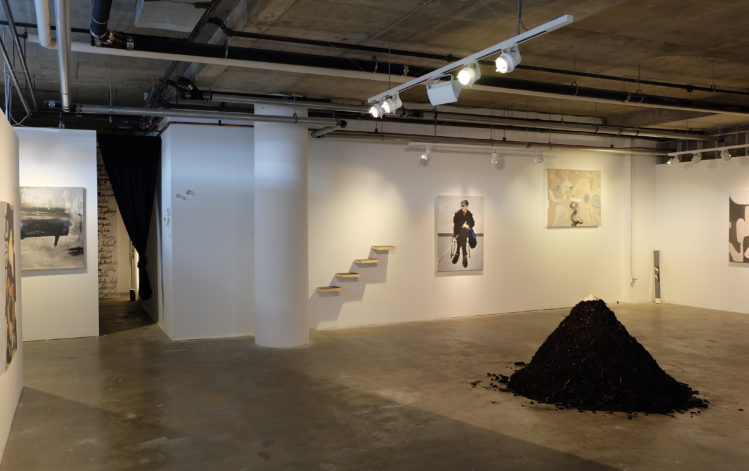
In January 2020, Vancouver-based artist and writer and Centre A’s curatorial apprentice Charisma Christal Thomas sat down with artist Lam Wong at Centre A and spoke about his artistic practice and how it was explored and introduced into his exhibition, the world is as soft as a volcano: a moving composition, at the gallery.
CCT: Hi Lam, I thought we could start this conversation learning a little about your background and how your upbringing, history and past experiences have influenced your art practice as a whole?
LW: I was born in 1968 in China, in a city called Xiamen. The year I was born was hailed as one of the most critical years for humanity. This is because all things broke loose in 1968. You know, like the man going to the moon, the Civil Rights Movement, riots in Paris, France, the assassination of Kennedy, the hippie movement, just everything. It was an important year in history and I was told that the year 2020, this year is going to be the next critical year for humanity. So that’s what the volcano piece is all about. A lot of things are just brewing and it comes to a sort of climax.
So I was born in Xiamen but my whole family immigrated to Hong Kong when I was a kid, in grade two. It was really hard at that time for any family to get out of China, but we managed somehow. My grandmother was born in Hong Kong and I think my mother was too. Anyway, there was a sort of connection to it. I basically grew up in Hong Kong. I stayed there for the next 10 years until the age of 19, and then came to Canada in 1987 with my two sisters, my mum, and my stepdad. We landed in Edmonton, Alberta in 1987. I went to high school there, my art school there and then moved to Vancouver when I turned 30, so that would be 1998. I’ve been living in North Vancouver with my wife and daughter ever since.
CCT: How do you feel these experiences have influenced your art?
LW: I don’t think that my diaspora and background really influenced my art practice. I mean this exhibition has had the most personal influence because it is about my mother, and in that sense, it is affected by the family and upbringing. But in terms of changing countries and living in different places, not exactly. I am working as a contemporary artist but the layers of meaning in my work are always informed by Eastern philosophy, especially Buddhism and Taoism. I have studied these philosophies most of my life. My work incorporates Western expressions, but the essence and soul of the work are Eastern. That’s something related to my upbringing especially because I studied Chinese first when I was younger. So I know the languages. I am fluent in those areas and am very comfortable with studying Chinese literature, especially Buddhist literature which helps my practice. Besides painting and installations, I also do tea ceremonies as performance. I use tea as a medium so I do a lot of tea-related art.
CCT: How do you explore these ideas of personal experiences and yourself in a show? How do you create? How do you take experiences and make them into art and how do you choose which narratives to portray?
LW: Well, there are a couple of approaches. Like when I have an area of interest, I’ll do research. For instance, the piano painting called CD 318 (Re-Performance); I spent months researching material for the painting and then I heard about the story of reperformance and all that [which I incorporated]. But my new series, the Free Form Biophilia series is just me throw[ing] in all the emotions. So it’s a very intuitive way to do a painting. There wasn’t any planning at all. I was explaining to Henry (Centre A’s Curator), it was kind of my way of attacking the canvas. Basically, I just have to prepare my mind into a certain space that I can paint, that I’m comfortable painting in, and once my mind was in that space, I would just take the canvas and pour myself into it. So it’s pure abstraction. I would also like thinking of them as emotions, and I am a transmitter of those emotions. So I called them “emotions under the microscope” because of what you would see through a microscope, like those kinds of amoebas and organic forms.
CCT: So, when you said that you prepare your mind before you start painting, how do you approach that, is it through meditative processes?
LW: Oh yeah, the mind has to be present and undistracted by anything. So I have this tea table in the studio where I do a bit of tea meditation. It is where I drink tea to calm down. I also have a meditation practice at home. I have a tea room that I use for tea meditation. I am also driven purely by the desire to paint. Sometimes, you just want to paint so much and in those moments you don’t want to do anything else, you just go to the studio to paint.
CCT: How do you decide which parts of your experiences you want to share with an audience? How do you navigate what you think is personal for you and what can be shared?
LW: This exhibition at Centre A deals with emotions from the most traumatic experience for me, which is losing my mother 10 years ago. She died quite tragically — falling down the stairs, 10 feet away from me. So there are a lot of heavy emotions and guilt and that is involved in that. It took me a long time. I showed Henry the painting I did of my mom a few weeks before she died. He kind of steered me into this more personal direction for the show. In terms of personal and emotional experiences, they were probably the heaviest in my life and after I lost my mom and got over that, I felt like I could do anything and nothing could be difficult anymore. Therefore it kind of fits into all these new abstraction series that I was doing about emotions.
CCT: Prior to this, did you show the work of your mother or is it something new that is being displayed for the first time?
LW: I did show it years ago in a show called “21 elements” but it wasn’t really about emotions at that time. It was more about figure paintings. My theme was about painting people in different art spaces. So this [painting of my mom] is called Blind Woman in a Photography Show, that was its context. But this show is much more about my personal struggles and it is a different context.
CCT: And working off that, thinking about working with this very personal subject matter? Is it something that is newer or different to you?
LW: This is the most personal show to date for me.
CCT: Were there difficulties that arose from that or was it something that you felt was a reflection of your work and it made sense to deliver this personal subject in this medium?
LW: I think this is a reflection of my work. It is a new approach because my other shows were much more philosophical and dealt with the notion of existence. This one does too but it is also a very direct and personal experience. The lightbox piece, for instance, called Looking at One’s Mortality, is me looking at my own death and the Volcano is a self-portrait of what is going on right now in the world, and the experience with my mother is seen in that painting [Blind Woman in a Photography Show]. So it is a new approach but I wouldn’t say it is more difficult. In a way, it was kind of liberating. I wanted to show that I can dedicate this show to my mother and describe emotions that can hopefully evoke something in the audience. Grief is a universal thing.
CCT: So do you feel that in this show, the art functions as a continuation of yourself or is it a reflection or a resolution of your problems or emotions?
LW: I feel like it is all of that together really. First of all, my art is an extension of myself. There is no question about it. It becomes a part of me and it is almost inseparable in that way. That’s just how I feel. Especially the paintings describing my own emotions. It is how I manifest into tangible artworks. I think it is all that you described.
CCT: For the exhibition itself, does it consist of past works and new works?
LW: I wanted to show the new works but what is most important to me about a show is the theme. In all my shows, I like the idea of all the individual artworks having a conversation with one another. So there are certain relationships and communications that inform each other. You then don’t see them individually, but rather as a part of something of a whole. And each one has a very special dialogue between them. These explorations are very important to me. That is my approach. So when I look at selecting the artworks, I will go to my portfolio or my collection and contemplate what should be included in the show and what works with the composition.
CCT: I know a huge part of this exhibition is that it is a “moving composition.” Do you feel that when you rearrange everything each week, it evokes different meanings or is all part of the same narrative from different perspectives, how do you think the viewer will engage with it or rather, how do you intend them to?
LW: The intention was more to do something different. To discover and surprise, was the main intention. We wanted to explore new ways of depicting and conveying meaning. Also, how the space is cut up. Space and shadow are important in my shows. All my elements also care for the shadows created. Also surprises, a lot of outcomes in the show are surprises because it depends on the space, the lighting, etc., which generate different contexts. So the rearrangement of the paintings is like that too. I think we are giving the audience different feelings and surprises.
CCT: So many people have a different dialogue with your work.
LW: Yeah, and one of the main subjects of my work is perception.
CCT: So now more to the technical side of the work, why do you choose the mediums you work in and how does that inform your art?
LW: Well, I am a painter. Whatever I am doing, painting is always essential to me. It is the heart of my practice. When I was young, I somehow knew I was always a painter. Painting has been around for ages, it is one of the most conventional mediums. So I want to create new ways of presenting paintings. I am more of an experimental painter. So even in this show, we have the painting sculpture in the corner with the feet. I just let it sit on the ground. I also built this staircase to create an emotional painting in reference to my mum and I created this sort of 3D shadow, creating metaphysical cues. I also started doing installations and performances in the last few years, which I quite enjoy! It is a way for me to directly connect with the audience.
CCT: What is the most important thing you want the audience to experience or take away from this show?
LW: My work is very existential and philosophical. One way or another, it is always about life. Whether it is about struggles or realizations, it is always about life. I think with the lightbox piece (Looking at One’s Mortality), it is very important for the audience to be aware of their own emotions and how to use intelligence and logic to understand them. Also to look at their own lives. From birth to death, that is all you get, so I would like them to use the work to contemplate about their own time and how much time we have in life, what is meaningful to them and how they are going to live it.
ABOUT THE INTERVIEWER
Charisma Christal Thomas
Charisma Christal Thomas joined the Centre A team as a curatorial apprentice under the mentorship of Centre A’s Curator, Henry Heng Lu. She is currently a fourth-year student at Emily Carr University of Art + Design where she is pursuing her Bachelor’s of Fine Arts. Thomas’s current work comprises illustration and printmaking, both of which are based in research methodologies and archival practices. With a focus on environmental sustainability rooted in a sense of place, Thomas looks for the intersection between artistic practices from her Malaysian and Indian heritage and the relationship that can be formed with nature. Her past exhibition experience include A Zine Launch Event at Access Gallery as part of Far Afield Collective and “A Clinic Unlike Any Other” a collaborative curatorial exhibition at Emily Carr University.









